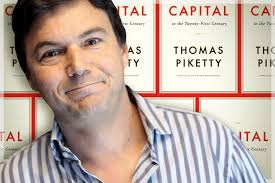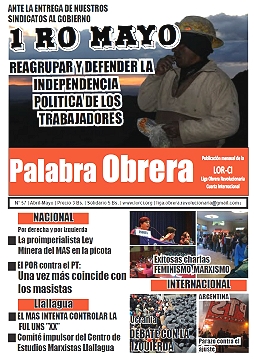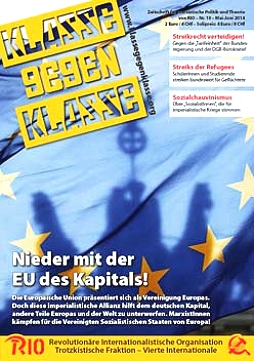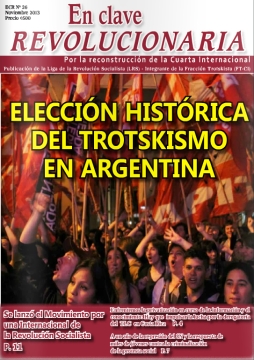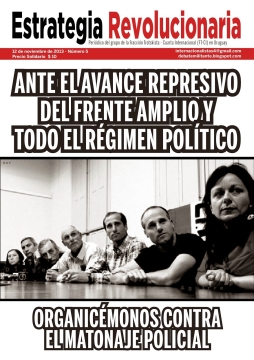Wall Street struggle to survive:
The US on the verge of the crash
02/10/2008
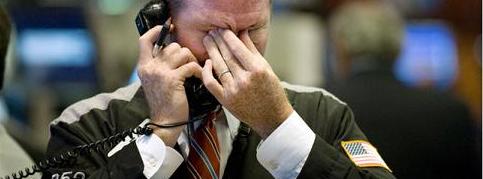
Originally published on September 18, 2008
Maybe the rescue will be successful, it cannot be ruled out. The US authorities and the central banks of the whole world are doing the impossible, although they are dragged down by events. But never since the crisis of 1929 has the US economy been so close to the crash. As the former Chairman of the Federal Reserve [the Fed], Alan Greenspan said, these are phenomena that happen “once-in-a-half-century, probably once-in-a-century.”
The crisis has already destroyed the neo-liberal dogma that the market fixes everything. But also, against what some neo-Keynesian economists maintain, this crisis is not a result of “neo-liberalism”; in reality, the collapsing financial hypertrophy is a byproduct of the only possible capitalist solution to the crisis of over-accumulation of capital, which has been taking place since the end of the postwar boom.
The falls of the US financial heavyweights, like Lehman Brothers, the fourth-largest US investment bank, which survived the Civil War, the two World Wars and the Great Depression, Merrill Lynch, which has been in existence for 94 years, and the colossal rescue of the gigantic insurance company AIG, can only lead to a greater discrediting of the US ruling class’ “free market” ideology, as well as its political and economic system, presented until recently as the capitalist panacea for the whole world.
The Fed, behind the events
The authorities of the Federal Reserve and the US Treasury, the only remaining “pilots” amidst the devastating financial hurricane, are being pulled along by the phenomenal shock wave.
Last week, forced by the role of the giants Fanny Mae and Freddie Mac in the real estate market, and especially because their fall would have sunk foreign investors like China, Russia or Japan, that are financing the enormous US deficit, they carried out the so-called “mother of all rescues.” This weekend, wishing to restore the appearance of market rules, while, on their knees, they were begging the “semi-healthy” small banks that exist in the US to save the “bad banks,” whether by buying them or continuing to do business with them, they let Lehman Brothers fall, which in turn hastened the sale of Merrill Lynch to the Bank of America, in an act of desperation, before Merrill Lynch could itself fail. The unprecedented development, unthinkable until recently, of the possibility of a US government default, that, although to a slight extent, began to be evaluated by the credit markets, was also hovering over the head of Henry Paulson, US Treasury Secretary, to adopt this course. But the Federal Reserve, two days after “drawing the line” on massive state rescues, at the final hour on Tuesday, with Treasury backing, went out to offer an $85 billion loan to avoid the bankruptcy of the main insurance company on earth, AIG, by, in fact, nationalizing the insurance market, although, contrary to expectations, without calming the markets. In turn, by other ways, they go on opening the faucet of liquidity even further, with increasingly desperate measures, like lowering the creditworthiness of the below par assets accepted at the liquidity windows of the Federal Reserve, up to including variable-rate assets, and even permitting companies to use deposits by their customers to finance their investment banking. That is, using deposits by those with savings accounts to avoid bankruptcy from their speculative activities. Incredible!
However, in spite of these "containment measures," the crisis is not stopping, and it promises to drag down new banks. The problem is that the Lehman bankruptcy could start a run on what is left of investment banking, like Goldman Sachs or Morgan Stanley or other investment banks or brokers that are part of the big commercial banks like, for instance, JP Morgan and Citigroup. The problems are repeated in other firms like Washington Mutual (WaMu), whose shares plummeted, as investors lost confidence in the ability of the main US savings bank to raise new capital or find a buyer who will let it continue business. In turn, another one of the financial firms that the market is focussing its concerns on is Wachovia, one of the largest commercial banks, that has suffered $16 billion in losses, as a result of the credit crisis caused by "garbage" mortgages. This is not counting the thousands of local or regional banks that could fail. As is obvious, there is no part of the US financial system that could be rescued in the biggest financial crisis since the Great Depression, that has at the same time, set off the biggest process of concentration and centralization of banking capital since the 1930’s. To put it clearly, we are facing the survival of the strongest, whether through the bankruptcy of firms with a smaller capital base, or the takeover and creation of mega-firms like the Bank of America, that has already absorbed the mortgage company Countrywide Financial and has now taken the investment bank Merrill Lynch, that has a tentacle in all the sectors of the US financial system. Although it still remains to be seen if this was a good deal or if, on the contrary, the "garbage" title deeds ("toxic," in the financial language of these days) that they got from the firms with problems they purchased could torment their new owners, by eroding their capital ratios (or base), something that, if it happened, would open an even more ominous prospect for the entire financial system since, the more banking mega-giants that are formed as a result of the crisis, the greater could be their fall.
In turn, the setback of the main mortgage bank of the United Kingdom, HBOS, in talks with its British rival Lloyds TSB, shows that the financial crisis is not limited to the US. The fears that HBOS will not be able to refinance 100 billion pounds in the coming months, nor find funds to do it in the present market conditions, have put this company in a coma.
The culprit is not "deficient" regulation, but the insatiable thirst for profits
The current setback of investment banking and its opaque character, have provoked the rise of a series of analysts that, confronted with the hypertrophy and the greater sophistication of the financial system, blame the regulatory agencies for behaving with liberal logic and not measuring up to the need to impose strong control on these banking practices. This explanation ignores the real causes and is, in turn, a self-interested vision from apologists for the system, currently in retreat, that naturalizes capitalism and considers that its excesses are the only problem. However, the explanation is different.
The development of investment banking and the securitization and titlization that accompanied it, like a shadow follows a body, in other words, the transformation of all credit into a negotiable security, that increased exponentially for the last thirty years, from the beginning of the neo-liberal offensive, were actions by capital (more precisely, capital as ownership) of subjecting and limiting the autonomy of the productive part of capital (more precisely to functioning capital) to increase the profits from invested capital. The universal titlization that was generated, to the detriment of the intermediary role of the old banking, towards a more direct financing, followed the logic of not being tied to management of real assets, in order constantly to seek the best yield. Increasing exposure to risk, even with a small capital base, or the fact that a large part of the expansion of financial products and services in the last five years originated in transactions between financial firms (incredible development of fictitious capital) should not blind us to the fact that the main reason for such changes in the financial system was to increase pressure on the management of enterprises, by approving of or penalizing their performance through buying and selling stock. The subprime mortgage crisis (or, better expressed, the sub-primary character of the US financial system) has punished this form of growth that the US ruling class had as a way of making up for the fall in profitability that devastated it in 1970, when the beneficial effects of the postwar-era boom were exhausted. This form of growth has revealed the fragile and unstable character of the current financial system, based on diversification and arbitrage of investors between different places as a way of getting superprofits, which, in turn, puts at risk the viability of the entire finanical system, as the current financial crisis, the biggest since the crash of 1929, shows.
Deregulation of the operations of the big corporations, approved by both Republican and Democratic administrations, removed all the legal limits to obtaining profits and promoted the accumulation of increasingly obscene levels of wealth in the hands of a financial oligarchy, to which both parties answer. Big sectors of the US industrial base were destroyed as part of this process, by relocating production in areas with cheap labor, that would allow getting superprofits, and provoking enormous social inequality, to the benefit of the more well-to-do groups in society, one of the structural bases of the historic decline of US capitalism.
And has it hit rock bottom?
It is still very premature to know whether a crash will be avoided. Wall Street has not seen the bankruptcy of an investment bank since the fall of Drexel Burnham Lambert in 1990, and today the interconnections of the sector through the derivatives market have grown beyond all limits. The debt of US financial groups to their counterparts has doubled since the beginning of the 1990’s, reaching 112% of the US gross domestic product (GDP). Lehman’s bankruptcy means the firm’s inability to face up to its current payments, a standstill in its ordinary activity, and its beginning a process of liquidating assets, with unpredictable consequences. We are talking about $600 billion up to June, with considerable exposure to mortgage titlizations of doubtful intrinsic value, the market for which has contracted to the point of being almost nonexistent. The adjustment to market prices ("mark to market"), that could be derived from the process of forced disinvestment from the US investment bank, could be devastating for the rest of its counterparts, unless the authorities continue opening an accounting window to avoid entering a spiral of losses that threaten to sweep away the entire financial system. In the case of AIG, the US insurance company that had broad exposure to the segment of the Credit Default Swaps (CDS), including those of Lehman, the authorities were unwilling to take another risk. The CDS are a type of derivative where it is agreed to pay a certain amount of cash (with a certain frequency) to the seller, in exchange for having protection against default on a bond or loan from an enterprise or country. The sums that AIG owed, in the face of the insolvency of the current credit system, turned AIG into a sure bet for bankruptcy. Overall, the commitments in derivatives are far in excess of the assets of the big banks. Morgan Stanley has an exposure ten times greater than Lehman to the derivatives market, although Lehman’s risk, compared to its weakened capital base, seems to have been worse. In turn, 97% of the derivatives in the hands of the commercial banks are held by the five biggest: JP Morgan Chase, Citibank, Bank of America, Wachovia and HSBC. Will these be the next victims? Who knows, but the waters are still too unsettled to let down one’s guard.
Where is the US and world economy going?
As we say in the beginning, never since the crisis of 1929 has the US economy been so close to the crash, that is, a situation with innumerable bank failures (with a loss of deposits of millions of savers), firms going bankrupt, massive unemployment (that in the 1930’s reached 28% in the US), etc. But, although there is not yet a crash to begin this generalized process, it is already possible to imagine an extremely severe recession in the main imperialist countries, with high unemployment. It is possible that we are entering a combination of the feared credit crunch (a drying up of credit) or lack of credit, and a synchronized emergency landing of the world economy. The dizzying collapse of Lehman Brothers and the absorption of Merrill Lynch have removed an enormous quantity of liquidity from the economy, to the extent that securities built up during decades of speculation are evaporating. As Paul Krugman explains in his column in The New York Times with the suggestive title, "Financial Russian Roulette,"... the system has been experiencing postmodern bank runs. These don’t look like the old-fashioned version: With few exceptions, we’re not talking about mobs of distraught depositors pounding on closed bank doors. Instead, we’re talking about frantic phone calls and mouse clicks, as financial players pull credit lines and try to unwind counterparty risk. But the economic effects - a freezing up of credit, a downward spiral in asset values - are the same as those of the great bank runs of the 1930s.... That creates the real possibility that 2008 could be 1931 revisited." (The New York Times, September 15, 2008).
US industrial production contracted by 1% in August (12% in the auto industry), a matter that happened totally unnoticed amidst enormous financial stagnation. But the strong interrelation between finances and the economy will soon make itself felt and could lead to the worst US recession in decades. First, the debt relief crisis pointed out above will reduce the availability of credit in the economy. Second, the fall in the price of housing and of stocks will reduce the so-called "wealth effect" and the resulting consumption. Third, the problems in the credit and stock markets will have a worldwide effect, because of which it will be less and less likely that world economic activity will go on supporting the US via increasing US exports, which, together with the temporary effects of the tax cut, has until now avoided a big fall in the US GDP.
On the other hand, the world economy is deaccelerating. The euro zone and Japan are already in recession. England is rapidly headed there. And the so-called "emerging economies" are beginning to show signs of weakness, if not panic. On Monday (September 15), worried by the effects that the bleak prospect that is closing over the world economy could have on its own economy, as well as the sharp decline in the price of housing in the summer, China reduced interest rates. In Russia, on Wednesday, the regulatory authorities decided to suspend operations in the two main stock markets of the country, to hold back the stock market collapse that was reaching its third consecutive day (on Tuesday, September 16, the two main indices, the RTS and the Micex, tumbled by 11.5% and 17.45%, respectively). Among the stocks hit were those of two of the largest banks in Russia, the Sberbank and the VTB, that today (September 17) depreciated around 20%. This collapse of the Russian markets is tied, on the one hand, to that of Wall Street, that has affected all the emergent markets, the strong geopolitical tension with the US that jumped with the war between Russia and Georgia, and finally, but not less important, to the rapid fall in the price of oil, that has caused worries in an economy supported mainly by its exports of raw materials. Likewise, we must wait to see how the crisis affects the international bonds market of the Russian enterprises, the true source of their financing.
Like in 1930?
So, will a crisis like that of 1930 be repeated? In his September 16 blog, Julio Sevares, from the Argentinean daily Clarín, basing himself on some definite elements, denies it: "In the 1930’s the world economy ... was fragmented, there was control of exchange and protectionism.... There was no common international currency, because the pound was weak and most of the time, non-convertible, and the dollar was not widespread, and the USA, the big international creditor, was unwilling to function as a moneylender of last resort; after the crisis, the Federal Reserve responded with monetary restriction, different from what is happening now. It is frequently mentioned that the Roosevelt administration responded with the expansive policy of the New Deal, but it is forgotten that in 1931, the US increased tariffs, worsening the world depression (the Smoot-Hawley Act), and that in 1933, it carried out a brutal devaluation of 30%. And in 1932, Great Britain responded to the USA’s protectionism with the Treaty of Ottawa, with preferential tariffs for the Commonwealth. France was engaged in accumulating gold, contributing to illiquidity [an insufficiency of cash], and Germany was in debt and in crisis after the departure of capital, that went to speculate in New York during the upturn. The responses of protectionism and devaluation impeded the recovery, which only arrived with rearmament. The level of commercial and family indebtedness was infinitely less than at present; for that reason, the mechanism of transmission of crisis now is more financial than commercial. Unlike what happened in the thirties, there are state systems with "anti-cyclical" instruments and international institutions of consultation and regulation." But while it is true that the situation is not the same as that of 1930, the "anti-cyclical" mechanisms can affect the tempos and the forms of the crisis, but a scenario of a widespread crash cannot be ruled out. To rule that out, right when capitalism is openly showing its explosive contradictions, would mean having confidence in capitalism and denying that it can open catastrophic situations, not only in the semi-colonial countries, like the Argentinean crash and default of 2001, but even in the main imperialist countries.
Furthermore, if we bear in mind the increasing geopolitical tensions at an international level, the accelerated hegemonic decline of the US and the growing weakness of the dollar, that, strangely, had been rising in its exchange rate since the end of June when US stocks were collapsing, owing to the strong manipulation of US currency by the US Treasury, with the active support of the Chinese central bank and, very probably, of Japan and Europe, an increasingly untenable operation that could accelerate the collapse of the monetary system based on the dollar, all these elements make one expect that the world economy has entered a period of profound commercial wars and inter-imperialist tensions, full of threats.
Millions could lose their jobs: Get ready for the catastrophe
The recession is just in its first stages. Strong contractions of the GDP are to be expected in the coming quarters. According to the last report from the International Labor Organization (ILO), the financial disaster could lead to an increase of five million in the number of unemployed people in the world in 2008.
For the US working class, the current financial collapse means a rapid growth of unemployment, of poverty, of the number of homeless people, and of suffering in society. The government, Wall Street and the presidential candidates of both parties are getting ready to unload the consequences of their own greed and incompentence onto the shoulders of the working class. The crisis is already devastating certain groups of wage earners, especially those who work on Wall Street or in the City in London, who got part of the crumbs from the incredible credit and speculative bubble. In the US, the epicenter of the current crisis, in the face of the catastrophe that capitalism represents for the workers, it is now necessary to raise a program to make the capitalists pay for the crisis, a program that would begin with the suspension of all foreclosures, distribution of the hours of work among all available workers, putting into operation a public works plan to restructure basic industries and repair the obsolete infrastructure of the country, creating millions of jobs financed by taxes on the big fortunes, and basically carrying out a true nationalization of the banking and financial system, but not in the service of the rich, Wall Street, and in the hands of the financial oligarchy; rather, under bank workers’ control and serving all workers. This program involves breaking with the Democratic and Republican parties and the adoption of an independent course by the working class.
This program, that is beginning to be ever more necessary for the US, to the extent that the crisis develops in the coming months and years, will be raised for action, for ever broader groups of the working class and the exploited of many countries in the world, since the crisis seems to be spreading like a poisonous cloud throughout the globe.
But basically the current crisis sets forth the need for the workers of the whole world to confront the collaborationist union bureaucracies of each country, that will be accomplices in the plans to unload the crisis onto their backs, and get organized politically not just on a national level, but by rebuilding proletarian internationalism and forging a new revolutionary workers’ international. Although today these ideas are very remote from the present consciousness of the workers as a result of years of social fragmentation, of the damages that endure in consciousness and organization because of the neoliberal offensive and the Stalinist experience, the severity and sufferings from the crisis could make many workers, especially their vanguard, again grasp in their hands the tools and the program of revolutionary Marxism, the only one that can lead them to defeat that caste of parasites and exploiters: the bourgeoisie and its governments, that threaten the whole planet with further and bigger catastrophes.
=====
Who will pay for the capitalist crisis?
"The First World that used to paint us as the Mecca is falling like a bubble," maintained the President [of Argentina, Cristina Kirchner] a few seconds after espousing the economic "model" of the Kirchners and predicting that Argentina is "steady in the middle of a heavy sea." Fantasizing about an economically solid Argentina avoiding the tumultuous crisis that world capitalism is experiencing, is really living in a bubble. The international conditions that favored Argentina’s growth cycle are disappearing. The current international capitalist crisis is the biggest since 1929; in spite of the hundreds of billions of dollars spent by the governments of the imperialist countries to contain the disaster, big banks continue to declare bankruptcy. The firms that are quoted on Wall Street are adding losses of their value of more than $4 billion dollars, the equivalent of 100 times the reserves of the Central Bank of Argentina. The US, Europe, Japan and the main economies are declining. The only horizon that capitalism has to offer is the combination of recession and inflation: more unemployment, more poverty and hunger for millions throughout the world. And this is what, in recent decades, they have been commissioned to present as the only viable system. The new international situation poses confronting the plans with which they will try to unload their losses on the backs of the workers, by overcoming the collaborationist union leaderships and preparing the mobilization of a powerful social and political force capable of imposing a program to make the capitalists pay for the crisis. Faced with the international nature of "the catastrophe that threatens us," it is urgent to rebuild the workers’ internationalism and a new revolutionary international that intends to put an end to this system of exploitation and oppression.
Translation by Yosef M.
